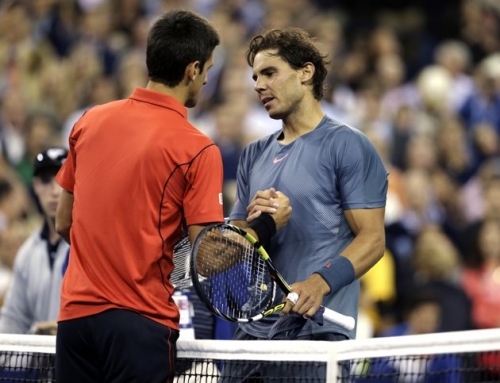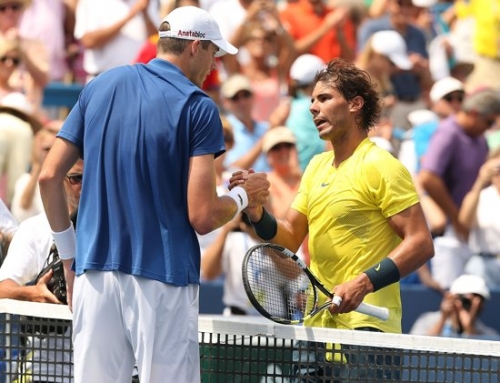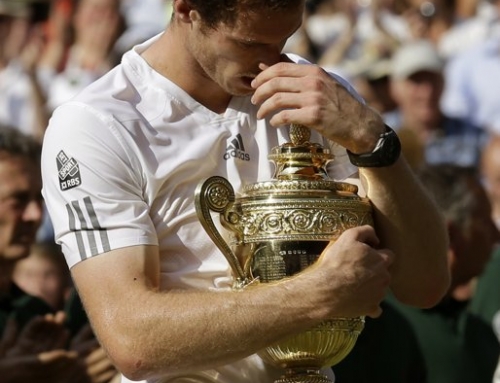 It’s 2011, but the question has been asked of Roger Federer since 2008. Is Roger Federer in decline? The obvious answer is yes. Federer no longer dominates the calendar like he used to. In his heyday, Federer would lose maybe half a dozen times a year, and most of them to Nadal on clay. He would easily win two Slams a year, and he’s the only pro to ever win 3 Slams in a year on three separate occasions.
It’s 2011, but the question has been asked of Roger Federer since 2008. Is Roger Federer in decline? The obvious answer is yes. Federer no longer dominates the calendar like he used to. In his heyday, Federer would lose maybe half a dozen times a year, and most of them to Nadal on clay. He would easily win two Slams a year, and he’s the only pro to ever win 3 Slams in a year on three separate occasions.
The last time this question was asked, well, prior to this year, was after Wimbledon. We had been so used to Federer’s impressive semifinal streak that to see him lose in the quarters of the French to Robin Soderling then the quarters of Wimbledon to Tomas Berdych. Well, it was a surprise.
As Federer exited Wimbledon, he admitted that his back and legs had been giving him some issues and he was looking forward to the rest. These were the excuses Federer had been more prone to drop given his poor results. Except Federer was right this time. He came back on tour and, short of winning a Slam, had the most productive post-Wimbledon runs of his recent career.
This included reaching the finals of Toronto, defending his title at Cincinnati, reaching the semis of the US Open with match points to reach the finals, winning Stockholm, winning Basel, reaching the finals of Shanghai, reaching the semis of Paris with match points (against Monfils), and winning the year-end championship. Of course, 2010 was the year of Nadal who won 3 of 4 Slams, his best effort ever. He finally captured the US Open completing the career Slam, much quicker than, say, Federer.
At the end of 2010, everyone felt it was Federer and Nadal who would dominate 2011, and order was restored again to the tennis universe.
Apparently, no one told Novak Djokovic that. Djokovic would go on to claim the first Slam of the year, beating Roger Federer in the semis for the second Slam in a row, and making short work of Andy Murray in the finals. Then, Djokovic would go on a tear losing only one match in months, a semifinal loss to Roger Federer at the French Open. But, in the process, he would win four Masters 1000 titles beating Nadal in the finals of all four, and having a four match winning streak against the top player. He would then win his first Wimbledon and beat Nadal in the finals in four sets making it his fifth straight defeat of Nadal.
In the meanwhile, Federer, who had pretty much only lost to Murray after Wimbledon (and Monfils), has not had nearly the successful season he had hoped for. This year, he’s lost to Nadal three times (in Madrid, Miami, and the French Open), to Djokovic three times (Australian Open, Dubai, Indian Wells), to Jurgen Melzer (Monte Carlo), Richard Gasquet (Rome), to Tsonga (Wimbledon, Montreal).
Every time Roger takes a break, he claims his practices have gone well, that he’s really close to a breakthrough, and every time he comes back (with the exception of last summer), he looks about the same. In the last two years or so, Roger gets very impatient playing tennis. He refuses to let rallies go ten shots or more in non-Slams. Watch his match with Tsonga, and find any point lasting 15 or more shots. Federer simply goes for a big shot and either he wins the point, or more likely, he makes an error. Djokovic is willing to engage in these long rallies. Federer is not.
Federer’s strategy seems to be to preserve his body. He doesn’t want to play long rallies because he’s concerned of the wear and tear. Better to occasionally lose to someone, rather than play long rallies. The other reason, I believe, he chooses to play shorter points is that he doesn’t want to fall into the trap of playing too defensively. To play offensively is to commit to a strategy that you need a lot of confidence. Thus, like they say to basketball players that shoot well “shooters gotta shoot”, meaning even if you miss a lot, you can’t be afraid to miss.
One glaring problem with Federer’s game is his return. Against the top players, he struggles to get enough returns in play. Against Jo-Wilfried Tsonga at Wimbledon, Federer had one break point. One! He was lucky that he plays well in tiebreaks. This plagued him at Montreal too. Federer could not stay even with Tsonga off the ground. Federer’s groundstrokes, which used to leave opponents gasping are now shots good players chase down. Even when Federer goes for “big” shots, they aren’t winners anymore. And it’s not as if Federer ever player stingy tennis when it came to errors. Federer’s always made a lot of errors. However, in the past, he just spaced it out well. He hit more good shots in between his bad shots.
The good news for Federer is that he generally still beats everyone ranked ten or below. Nadal has strange “bad” losses. His loss to Ivan Dodig and last year to Guillermo Garcia-Lopez, for example. Nadal can lose to a hot-hitting player ranked 40 spots below him. Federer generally doesn’t do this.
Obviously, while everyone is going to pay attention to Novak Djokovic in Cincinnati, the eyes should focus more on the rest of the top 3. Andy Murray lost tamely to Kevin Anderson, playing poor tennis. Is he ready to bounce back after that effort? He’s often played poorly in singles in tournaments where he plays doubles with his brother, almost as if he sacrifices the tournament to focus on doubles.
Rafael Nadal also lost early. As the most recent number one, he generally does well prepping to play opponents. There were some signs of things he was working on playing Dodig, mostly attacking the serves. But there’s still tension whether Nadal has lost some confidence or not. Nadal had a year-long loss of confidence between Wimbledon of 2009 to Monte Carlo of 2010. He won no tournaments in this period. It’s not that he was playing bad. By all accounts, anyone who had Nadal’s year with his results would have been thrilled, but since it was Nadal, and we expect him to win tournaments, we scratch our heads at the poor results. Nadal would, of course, go on to finish 2010 with his best year ever.
The Djokovic losses do seem to have rattled Nadal. When Nadal was chasing Federer, he could always point to two things. First, he beat Federer in the first encounter in Miami. Second, he nearly always beat Federer on clay. These facts gave him and give him confidence.
And Nadal had that kind of confidence over Djokovic as well. Sure, Djokovic would occasionally beat Nadal, but when Nadal was rock solid, he withstood all sorts of pressure by Djokovic, most notably in 2009 Madrid when Djokovic had match points and yet Nadal pulled miracle shots to win that match. That confidence vanished when Djokovic beat him five times this year. The first time was key. This was Indian Wells. Nadal wanted to outserve and outhit Djokovic. For a set, he did exactly that. But his serve percentage dropped, and Djokovic eventually began to play better.
A similar thing happened in Miami. Djokovic again ceded a set to Nadal, but managed to come back and win a third set tiebreak.
But as Nadal-Djokovic has become the rivalry of 2011, Federer has only beaten these two once. He hasn’t played Andy Murray in 2011 yet, mostly because as the third seed, and Murray as the fourth seed, they can’t meet each other except in the finals, which means both players would need upsets. This is one reason Djokovic and Murray used to rarely meet. Djokovic was 3 and Murray was 4.
And now Tsonga has built some confidence beating Federer. Of course, one has to wonder what is going on with Tsonga and his current mystery ailment.
The key will be Cincinnati. Roger Federer will appear to be in trouble if he can’t reach the semifinals. We’ll worry about whether he can win the title later on.
But thus far, Federer has seen a guy he beat several times last year move past him, and now the question is, what can he do with his game to compete. His game looks pretty much as it has the last few years. The same issues plague it, and there’s even a concern whether he is struggling with the return game.
This next Masters 1000 event should hopefully give us more answers not only about Roger, but Rafa, and Andy too.




![[US Open Men’s Final] Can Djokovic beat Nadal in the finals?](https://www.essentialtennis.com/wp-content/uploads/2013/09/20130909djokovic-500x383.jpg)


![[French Open] The tactics of the Djokovic-Nadal semifinals](https://www.essentialtennis.com/wp-content/uploads/2013/06/20130607nole-500x383.jpg)